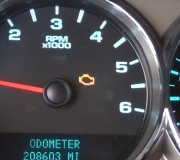You're a wonderful human being, and thank you for the offer, but my goal is to help people, especially fellow older Chrysler owners. The owners of this site are gracious enough to compensate us for that help already on your behalf. Being unemployed and waiting out this miserable winter, sitting on this computer is all I have to keep me occupied until the glacier in my yard recedes! I'd rather have you contact them if you're happy with the answers that come from my dart board.
If you feel like thinking I'm a genius, you just go right ahead, but you should know that I also own an '88 Grand Caravan that I love dearly. I'm saddened by all the rust since Wisconsin thinks throwing a ton of salt on an ounce of snow to make slush makes safer roads. I also have an '89 Grand Voyager and a '95 Grand Caravan so I know those vehicles real well. It helps that I worked for a very nice Dodge dealer too during all of the '90s.
One of the real common things we ran into in the early '90s was defective MAP sensors. The clue, which your's truly figured out, was you could drive the van into the shop, vs. Having to push it, if you kept moving the gas pedal. That was the clue you observed that made the diagnosis so easy, so you should be patting yourself on the shoulder.
That original design MAP sensor was developed by GM. They had a ton of trouble with it so they sold them to Chrysler. That one had a piezoelectric crystal with a rubber diaphragm that tugged on it through a vacuum hose. That crystal is similar to that used in a child's phonograph needle. It was protected by a layer of jelly. One of the most common causes of failure was overfilling the gas tank. If you stuff the tank really full, then drive a few dozen miles or more, you were okay. If it was real cold outside, you were okay too. If you stopped filling when the pump kicked out, then finished out the dollar, you were still okay. It's when you really kept forcing in more gas, then parked it right away on a warm day that you had problems. The vapors inside the tank would expand and work their way through the vacuum hoses to the MAP sensor where they would deteriorate that protective jelly. Eventually the fuel vapor would eat away at the rubber diaphragm and the sensor would stop responding. Those sensors are so accurate, they could be used to measure engine speed because they react to every pulse of vacuum when a piston takes a bite of air. The MAP sensor's reading also represents barometric pressure before the engine is running. When the Engine Computer does not see a change after the engine starts, it knows it can't rely on that reading so it "injects" an approximate reading and runs off of that. That approximate reading is based on all the other sensor readings and conditions it knows. It knows the engine is running, and when it sees a change in the throttle position sensor's reading, it knows the engine needs more fuel. Normally the MAP sensor has the biggest say in how much fuel enters the engine and the TPS just fine tunes that amount based on direction and speed of movement. When the computer knows the MAP sensor is wrong, it uses the TPS as a backup strategy to try to run the engine as best as possible.
The later design MAP sensor uses a "strain gauge". That is basically a very thin piece of wire wrapped around a plastic core. The wires are attached to the rubber diaphragm and the vacuum hose. When vacuum pulls on those wires it stretches them a little longer which increases their electrical resistance by a very tiny amount. Circuitry amplifies those changes so the computer can use that signal. Problems pretty much disappeared with that sensor with that design which is what is used now. Besides yours, the last one I ran into was on an '88 Aries that belonged to a former coworker. That was about five years ago. That's not too bad for a sensor that used to have a 100 percent failure rate.
I'm happy I could help with this problem but you have to understand that I only know five things and you asked about each one. I might not appear so smart next time!
Saturday, April 23rd, 2011 AT 8:30 PM


